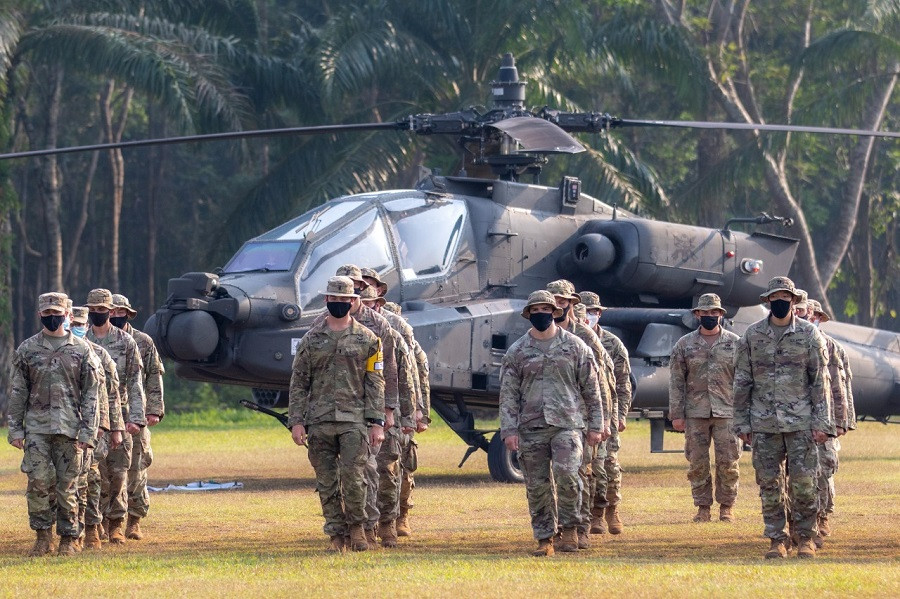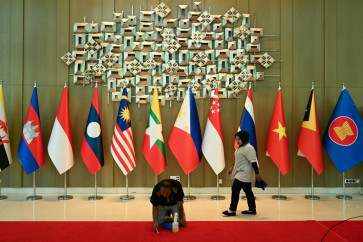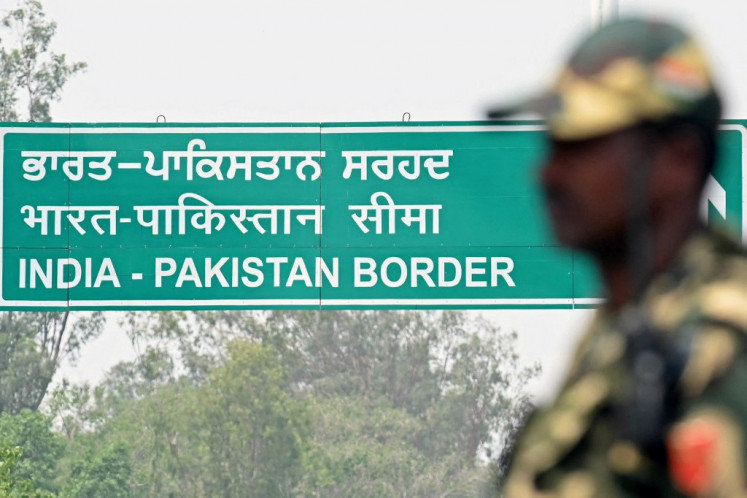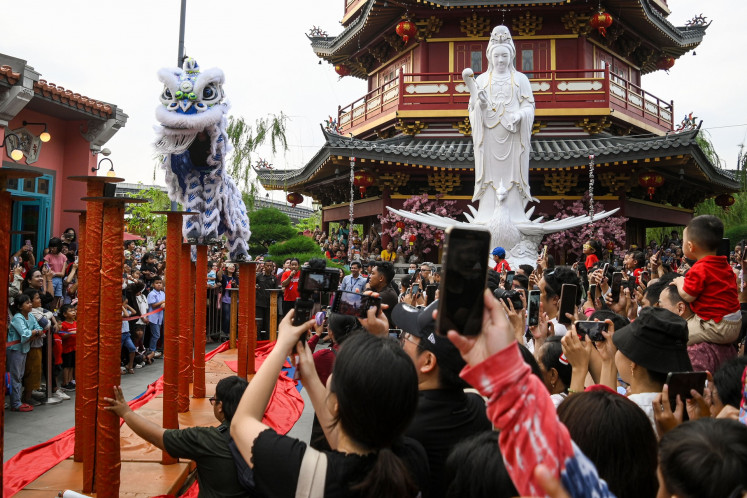Indonesia, US eye more integrated military drills
Last year’s Garuda Shield exercise involving both nations deemed successful.
Change text size
Gift Premium Articles
to Anyone

I
ndonesia and the United States are exploring the possibility of integrating their joint military exercises across all branches amid simmering tensions in the South China Sea, further bringing the two sides closer together amid a tense superpower rivalry.
Indonesian Military (TNI) commander Gen. Andika Perkasa met with Admiral John C. Aquilino, commander of the US Indo-Pacific Command, in Jakarta on Monday to discuss how both their nations’ armed forces could better link up.
Building on last year’s successful Garuda Shield exercise, which he oversaw as then-army chief of staff, Andika said the TNI and the Indo-Pacific Command were now working on more integrated exercises involving all its forces.
Garuda Shield is considered the largest joint drills the two sides have bilaterally staged thus far, with more than 3,000 army personnel deployed concurrently on the islands of Sumatra, Kalimantan and Sulawesi over a span of two weeks in August.
It is hardly the only joint exercises the two sides regularly stage, as other TNI branches have their own joint drills with American counterparts. However, Andika specifically insists on improving interoperability with the US as Indonesia works to improve its military capabilities to better maintain territorial integrity.
The military commander said the TNI would take all the help it could get from friendly countries like the US, given its own limited capacity to oversee the archipelago’s vast territorial waters, which is nearly five times as large as its land mass.
“We are planning for an exercise that does not eliminate any [existing] training. We want better forms of training among our forces across all branches – from planning to staging – so we all get a sense of integration,” he told reporters on Monday.
Read also: Indonesia, US hold largest joint military drills
Indo-Pacific drive
On his end, Aquilino said assessing more complex training was important for both Jakarta and Washington in order to meet the security challenges of the region, particularly in the South China Sea, where several littoral nations have locked horns with China for decades over Beijing’s illegal claims to the waters.
Uncoincidentally, the busy maritime trade route is just one of several strategic flashpoints in the US-China rivalry. Beijing has insisted that the Pentagon’s freedom of navigation operations would “stir up tensions”, even though China itself has been building up military assets on disputed maritime features there.
The US, meanwhile, is adamant on keeping trade routes free.
“The US is a Pacific nation; we’ve operated in the Pacific for many years and we will continue to fly and sail [...] anywhere international law allows. We do that with all of our partners in the region, Indonesia being one,” said Aquilino, who is in charge of the US’ largest military command.
Separately, China’s Ambassador to ASEAN Deng Xijun said the US, as an “outsider”, was only stirring tensions, and accused Washington of causing a nuclear submarine accident and an F-35 fighter jet to crash in the South China Sea.
He also insisted that Washington’s Indo-Pacific strategy only served to sow division within the region.
“From strengthening the Five Eyes [intelligence alliance] to peddling the Quad [diplomatic group] and piecing together the AUKUS [trilateral defense partnership], the US is staging a 5-4-3-2 formation in the Asia-Pacific,” the envoy said recently.
“This is by no means some kind of blessing for the region, but a sinister move to disrupt regional peace and stability,” he added.
The Chinese diplomat referred to a defensive soccer strategy, which coincidentally sums up the roster of allies the US has employed in its bid to contain China’s expansion: the Five Eyes group involves Australia, New Zealand, Canada and the United Kingdom; the Quadrilateral Security Dialogue groups the US with Australia, India and Japan; and AUKUS is a US partnership with the UK that primarily benefits Australia.
The Indo-Pacific itself is a strategic term employed by the US that, whether intentionally or not, redefines a regional order centered around China as one that empowers US partnerships.
Prior to Andika’s rise to the top of the TNI command, Indonesia had stuck to its “independent and active” foreign policy of maintaining balanced relations with the two superpowers, especially with China, it being a key economic partner.
On the flip side, the nation’s defense posture is aligning with US interests, partly helped by the US-educated military leadership under Andika and Defense Minister Prabowo Subianto.
Monday’s meeting follows US approval in February of the sale of 36 fighter jets to Indonesia in a deal worth US$13.9 billion, which closely coincided with Jakarta’s other defense purchase agreement with France, after pressure from Washington to drop negotiations with Russia over the procurement of Sukhoi jets.
Read also: Indonesia on major defense spending spree
Military preparedness
Aquilino said US-Indonesian military exercises were also designed to ensure that training objectives on both sides are met. For Indonesia, this includes protecting its interests in the North Natuna Sea, an area adjacent to the South China Sea that has seen an uptick in illicit maritime activities by Chinese vessels.
Indonesia is not a claimant in the South China Sea dispute, but Beijing insists it has legitimate interests in an area overlapping with an exclusive economic zone in the Natunas. Jakarta has brushed off Chinese attempts to bring it to the negotiating table.
Fully aware of the regional dynamics, Andika said that by working closely with the US Indo-Pacific Command, the TNI would be able to assess its weaknesses and improve its capabilities in patrolling Indonesia’s vast territory.
“We have had several encounters [with China], but we also need to restrain ourselves and not take action without approval from the top of the chain of command. We’ve had to shadow them several times, [but] the most important thing is that we show up [in Natuna] and that we intend to communicate this,” he said.
Indonesia’s defense capabilities are still dwarfed by the size of its territory, and have not been allowed to flourish even despite decades of military-backed dictatorship.
Prabowo has been shopping overseas for defense equipment in recent years, in an effort to complete Indonesia’s minimal essential forces – a long-term project to modernize the military.
However, Andika also acknowledged the budgetary constraints that the defense sector faces at a time like this, even though there is some urgency to defending the nation’s porous borders.
“When it comes to infrastructure [needs], we have to talk about budgets. And when it comes to budgeting, there's just no shortcut. Every military wants to have it all – fighter jets, cruise ships, frigates – we just have to be smart about it,” Andika said.









